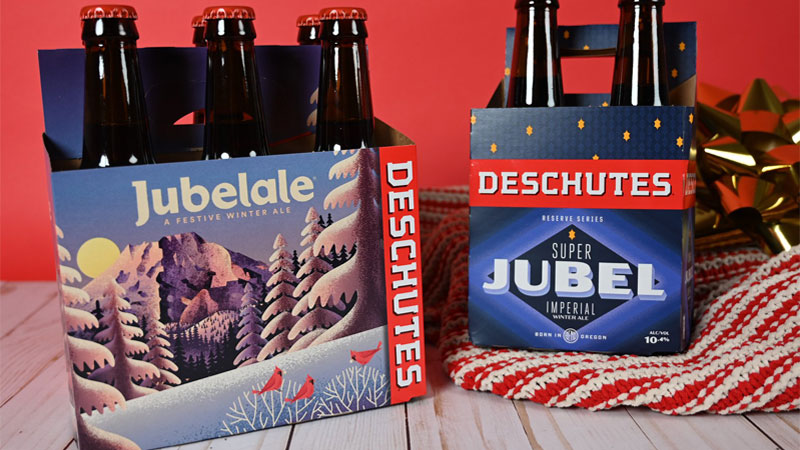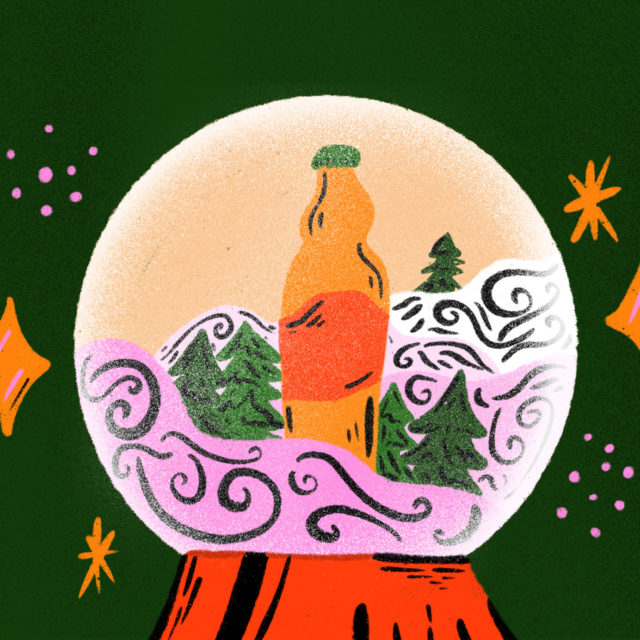This time of year, there are plenty of big barrel-aged barleywines, and sweetened and flavored pastry stouts flooding the market. But there is a simpler, more subdued style that has been a winter staple for the last 30 years or more. It’s a beer that requires the brewer’s restraint. The alcohol is elevated, but not too high, there is malt flavor but the balance isn’t overwhelmingly sweet. It’s the winter warmer.
“Winter warmer” means different things to different brewers. According to our guideline-writing overlords at the BJCP, classic English winter warmers such as Samuel Smith’s Winter Welcome and Young’s Winter Warmer are commercial examples of the “British Strong Ale” style. Even the guidelines admit that grouping is more of an entry category that “fits in the style space between normal gravity beers (strong bitters, brown ales, English porters) and barleywines,” than it is a defined style.
Then again, Harpoon Winter Warmer, which many an East Coast craft beer drinker would consider the quintessential example, is tucked in the “Winter Seasonal Beer” style. This category is ambiguous, per BJCP guidelines, to “allow for brewer creativity as long as the resulting product is balanced and provides some spice presentation.”
Four breweries churning out some of the most loved winter warmers in the U.S. over the last three decades give their point of view on what makes for a winter warmer, and how to make one at home.

When Building a Winter Warmer Recipe, Consider the Classic English Style
According to Odell Brewing co-founder Doug Odell, a winter warmer should have “malty character with enough hops to balance that sweetness and add a little kind of spice to it, but not the sense of holiday spices.” Odell has been releasing the winter warmer Isolation Ale seasonally since 1999. Over all that time, the recipe and flavor profile has stayed the same — complex malt flavors of caramel, toffee, and dried prune taking center stage with just a hint of English Fuggle and Mt. Hood hops for that herbal spiciness he describes. The hops also add a hint of bitterness to the beer so it “doesn’t taste like you’re drinking sweet cough syrup,” Odell adds.
The Jubelale from Oregon’s Deschutes Brewery has a similar flavor profile, emphasizing the British flavors synonymous with winter warmer: dark fruit flavors from crystal malt, and subtle cherry and berry notes from English yeast, says barrel master Ben Kehs.
Both Kehs and Odell agree that using a few different kilned and stewed malts boosts complexity, but there shouldn’t be too much impact from roast malt, if any at all. Odell says roast malt is appropriate in other styles at his brewery, such as his flagship Scotch-style amber ale 90 Shilling for dryness and chocolate flavors. However, there isn’t any room for roast character in his interpretation of a winter warmer. In Isolation Ale he is looking for a fuller mouthfeel with more caramel and toffee-forward flavor.
Kyle Matthias, Deschutes’ head R&D brewer, recommends that homebrewers avoid trying to build a winter warmer recipe as complex as possible, and to instead think of the desired malt flavor. “Roughly 10 percent of the grist bill for Jubelale is C150 (Crystal 150),” Matthias says. “You don’t necessarily need more types of malt to deliver an awesome beer.”

Winter Warmer Fermentation: Subtle Yeast Character Is Key
English yeast is the standard for the winter warmer style and is used at both Odell and Deschutes. Kehs emphasizes the importance of controlling fermentation temperature to get the right flavor balance in a winter warmer. He says Jubelale ferments around 63 degrees Fahrenheit to keep the yeast-derived flavors in check. If the fermentation is too warm early on, the yeast will produce signature English berry and cherry esters that will compete with the malt flavor that is essential to this subtle style.
Odell notes that the brewery is distributing 15 percent more Isolation Ale this year compared to last year. “You stay home more and you want to be cozy in your house. So Isolation [Ale] and beers like it fit the mood,” he says.
Spicing a Winter Warmer Recipe
Even the brews that the BJCP would consider a “winter spice beer” or “holiday seasonal” don’t pack the adjunct flavor punch of pastry stouts or barrel-aged beers.
“The most important thing we tried to do with [Harpoon] Winter Warmer was keep it approachable,” Al Marzi, chief brewing officer of Mass Bay Brewing, parent company of Harpoon Brewery, says. “We wanted the cinnamon and nutmeg to shine through … but it had to be the type of beer that you could still drink a few of.”
This balance between malt and spice requires a delicate touch — and special brewing techniques for those brewing their own at home, too.
Adding Spices
The method used to add spices on a commercial scale looks more like a homebrewing maneuver than it does a step in a large-scale production cycle. For Great Lakes Brewing’s Christmas Ale, brewers use a “giant tea-strainer-type device,” says education coordinator Michael Williams, filled with 20 pounds each of fresh peeled ginger root and whole cinnamon sticks that steep for the duration of the boil. The result is “a good amount of spice, but not so much that it ends up overwhelming the palate,” Williams says.
This step can be recreated at home with a muslin bag filled with spices. For a closer replication of Great Lakes’ method, homebrewers can use a stainless steel hop tube. (Just remember not to pack the spices too tightly — hot wort needs to be able to move between pieces in order to best extract their flavors and aromas.)
Harpoon takes a different approach to achieve faint notes of cinnamon and nutmeg in its beer, Marzi says. “We have them ground up and added straight to the whirlpool. The biggest thing to watch out for when using any dry spice is to make sure you don’t overdo it — nutmeg in particular,” Marzi says. He suggests erring on the more conservative side when adding spices in general because they can quickly become “way too much.” An overly spiced beer will have an unpleasant flavor balance but also less obvious side effects, such as a rough, drying mouthfeel from tannins extracted from spices; or a slick, oily mouthfeel and reduced head retention because of oils absorbed from spices.
One option that is available to homebrewers, but not necessarily professional brewers, when striking this balance is steeping spices in the fermenter. Spices and the muslin bag or stainless-steel steeper need to be thoroughly sanitized, then soaked in the fermenting wort or finished beer to extract more flavor. (Spices can be sanitized by a quick boil in a small amount of water or soaking in a small amount of vodka overnight.)
Using Alternate Fermentables
Legacy winter warmer brewers emphasize restraint and drinkability, along with sweet malt and spiced flavors, as hallmarks of this seasonal style. Homebrewers should strike the same balance.
Great Lakes’ Christmas Ale uses 612 pounds of local honey sourced from T.M. Klein and Sons in each 75-barrel batch. Instead of being added to the fermenter where it would have the most flavor impact, it’s mixed with the wort as it flows into the boil kettle. This way, the honey lightens the body of Christmas Ale while contributing only subtle honey notes to the overall aroma and flavor of the beer, according to Williams. “It’s a great way to up the drinkability,” he says.
When calculating the target original gravity (OG) for a recipe that uses honey, remember that “honey is essentially going to ferment out almost a hundred percent,” says Williams. So, it can be considered equal to dextrose or pure sugar when writing the recipe. The fact that the honey is fermented completely into alcohol, leaving behind no protein, dextrins, or other contributors to mouthfeel is the reason a honey addition will cause a drier beer with a lighter body than the same recipe without added honey. For homebrewers searching for more flavor from honey or other alternate fermentables (like Belgian candi sugar or molasses), these substances can be added directly to the fermenter as well.
Whether the goal is a classic English-style winter warmer, or to up the ante with lots of seasonal spices, simply remember this style requires as much moderation and balance as any other. Brew your own with that in mind, and you’ll have a cozy, flavorful beer worthy of the winter warmer title — no matter what the BJCP calls it!

